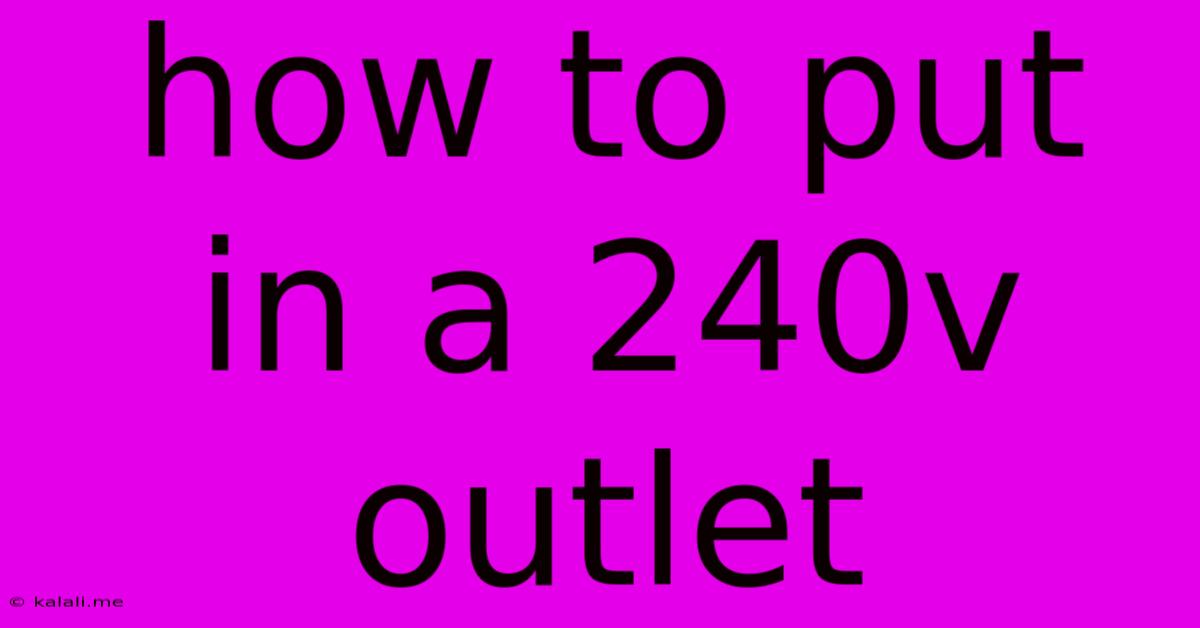How To Put In A 240v Outlet
Kalali
Jun 08, 2025 · 4 min read

Table of Contents
How to Install a 240V Outlet: A Comprehensive Guide
Meta Description: Learn how to safely install a 240V outlet in your home. This comprehensive guide covers everything from choosing the right outlet to wiring and testing for a successful installation. Perfect for DIYers tackling appliance upgrades!
Installing a 240V outlet is a crucial step for powering high-wattage appliances like electric ranges, ovens, dryers, and hot tubs. While it might seem daunting, with careful planning and adherence to safety regulations, it's a manageable DIY project for homeowners with some electrical experience. This guide provides a step-by-step walkthrough, but remember – if you're uncomfortable working with electricity, consult a qualified electrician. Your safety is paramount.
1. Planning and Preparation: Assessing Your Needs and Gathering Supplies
Before you even touch a wire, thorough planning is essential. This includes:
- Identifying the appliance's power requirements: Check your appliance's specifications to confirm it needs a 240V outlet and determine the amperage (amps) rating. This will dictate the size of the breaker and wire you'll need. Common amperages include 30A and 50A.
- Determining the outlet location: Choose a location close to the appliance, accessible, and away from water sources. Consider the proximity to your electrical panel for efficient wiring.
- Gathering necessary materials: This includes:
- 240V outlet (duplex or single, depending on your need)
- Appropriate gauge wire (e.g., 8-gauge for 40A, 6-gauge for 50A – consult the National Electrical Code (NEC) for specific requirements)
- Wire connectors (wire nuts)
- Electrical box (if needed)
- Circuit breaker (matching the outlet's amperage)
- Voltage tester
- Wire strippers/cutters
- Screwdrivers (Phillips and flathead)
- Fish tape (if running wires through walls)
- Cable clamps
2. Turning Off the Power: Safety First!
This is arguably the most important step. Always turn off the power at the breaker box before working with any electrical wiring. Double-check the breaker is off by using a non-contact voltage tester on the wires at the intended outlet location.
3. Running the Wiring: Connecting to the Power Source
This step depends heavily on your existing wiring and the location of your electrical panel.
- New Circuit: If you're adding a new 240V circuit, you'll need to run a new cable from your panel to the outlet location. This often involves drilling holes in walls and using a fish tape to pull the wire through. Secure the cable using cable clamps at intervals along the run.
- Existing Circuit: If tapping into an existing circuit, ensure it's adequately rated for the appliance's power requirements and that the wire gauge is appropriate.
4. Wiring the 240V Outlet: A Detailed Explanation
The wiring process for a 240V outlet differs from a standard 120V outlet. Incorrect wiring can lead to serious hazards, so carefully follow the instructions provided below, referencing your outlet's specific diagram:
- Grounding: Connect the bare copper ground wire from your cable to the ground terminal on the outlet.
- Hot Wires: Connect the two hot wires (usually black and red) from your cable to the appropriate terminals on the outlet. The order may vary, so always refer to the outlet's instructions.
- Neutral Wire: Although 240V circuits typically don't use a neutral wire, some configurations might. Refer to your circuit's wiring for a neutral connection.
- Secure Connections: Tightly fasten all wire connections to the terminals. Use wire connectors (wire nuts) to neatly join wires together if necessary.
5. Mounting the Outlet and Testing
Once the wiring is complete, carefully tuck the wires into the electrical box and mount the outlet. Before turning the power back on, use a voltage tester to confirm the correct wiring and absence of any short circuits.
Finally, restore power at the breaker box. Test the outlet with the appliance to ensure it's functioning correctly.
6. Important Considerations and Safety Precautions
- Local Codes and Regulations: Always comply with your local electrical codes and regulations.
- Professional Help: If you’re uncertain about any aspect of this process, don't hesitate to contact a licensed electrician.
- Proper Tools and Equipment: Using the right tools and following safety practices minimizes risks.
- Regular Inspections: Periodically inspect your 240V outlets and wiring for any damage or wear.
Installing a 240V outlet correctly ensures the safe and efficient operation of your high-powered appliances. By following these steps and prioritizing safety, you can confidently complete this DIY project. However, remember that electricity is dangerous, and it’s always better to err on the side of caution. If you're unsure, call a professional.
Latest Posts
Latest Posts
-
Can A Sniper Round Penetrate A Tank
Jun 08, 2025
-
Attributeerror Module Serial Has No Attribute Serial
Jun 08, 2025
-
Do You Need To Refrigerate Vinegar
Jun 08, 2025
-
Hope This Email Find You Fine
Jun 08, 2025
-
Car Only Starts When Jumped But Battery Is Good
Jun 08, 2025
Related Post
Thank you for visiting our website which covers about How To Put In A 240v Outlet . We hope the information provided has been useful to you. Feel free to contact us if you have any questions or need further assistance. See you next time and don't miss to bookmark.